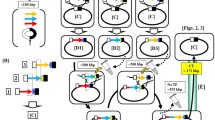Summary
During transformation in Bacillus subtilis, donor and recipient DNA are initially associated by non-covalent bonds. The donor and recipient moieties later become covalently joined. The molecular weight of the donor component, when freed from the noncovalent complex by sucrose gradient sedimentation under alkaline conditions, ranges from 1 to 5×106, with an average of about 2.5 to 3.0×106. The latter values are in good agreement with previous measurements of the size of the integrated donor fragment.
Similar content being viewed by others
References
Bancroft, F.C., Freifelder, D.: Molecular weights of coliphages and coliphage DNA. I. Measurement of the molecular weight of bacteriophage T7 by high-speed equilibrium centrifugation. J. molec. Biol. 54, 537–546 (1970).
Bodmer, W.F., Integration of deoxyribonuclease-treated DNA in Bacillus subtilis transformation. J. gen. Physiol. 49 No. 6, part 2, 233–258 (1956).
Bodmer, W.F., Ganesan, A.T.: Biochemical and genetic studies of integration and recombination in Bacillus subtilis transformation. Genetics 50, 717–738 (1964).
Boyce, R.P., Setlow, R.B.: A simple method of increasing the incorporation of thymidine into the deoxyribonucleic acid of Escherichia coli. Biochim. biophys. Acta (Amst.) 61, 618–620 (1962).
Burgi, E., Hershey, A.D.: Sedimentation rate as a measure of molecular weight of DNA. Biophys. J. 3, 309–321 (1963).
Cassuto, E., Radding, C.M.: Mechanism for the action of λ exonuclease in genetic recombination. Nature (Lond.) New Biol. 229, 13–16 (1971).
Dubnau, D., Cirigliano, C.: Fate of transforming DNA following uptake by competent Bacillus subtilis. V. Size and distribution of the integrated donor segments. J. Bact. 3, 488–494 (1972).
Dubnau, D., Davidoff-Abelson, R.: Fate of transforming DNA following uptake by competent Bacillus subtilis. I. Formation and properties of the donor-recipient complex. J. molec. Biol. 56, 209–221 (1971).
Fox, M.S., Allen, M.K.: On the mechanism of deoxyribonucleate integration in pneumococcal transformation. Proc. nat. Acad. Sci. (Wash.) 52, 412–419 (1864).
Hutchinson, F., Hales, H.B.: Mechaism of the sensitization of bacterial transforming DNA to ultraviolet light by the incorporation of 5-bromouracil. J. molec. Biol. 50, 59–69 (1970).
Laipis, P.J., Olivera, B.M., Ganesan, A.T.: Enzymatic cleavage and repair of transforming DNA. Proc. nat. Acad. Sci. (Wash.) 62, 289–296 (1969).
Notani, N., Goodgal, S.H.: On the nature of recombinants formed during transformation in Hemophilus influenzae. J. gen. Physiol. 49 (No. 6, part 2), 197–209 (1966).
Studier, F.W.: Sedimentation studies of the size and shape of DNA. J. molec. Biol. 11, 373–390 (1965).
Zadrazil, S., Fucik, V.: Fate of transforming DNA in Bacillus subtilis strain sensitive to methyl methanesulfonate. Biochem. biophys. Res. Commun. 42, 676–683 (1971).
Author information
Authors and Affiliations
Additional information
Communicated by W. Maas
Rights and permissions
About this article
Cite this article
Dubnau, D., Cirgiliano, C. Fate of transforming DNA following uptake by competent Bacillus subtilis . Molec. Gen. Genet. 120, 101–106 (1973). https://doi.org/10.1007/BF00267237
Received:
Issue Date:
DOI: https://doi.org/10.1007/BF00267237




